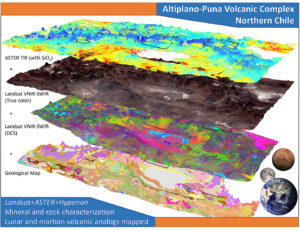Ito, G. ; Flahaut, J. ; Gonzalez-Maurel, O. ; Godoy, B. ; Payet, V. ; Barthez, M.
Remote Sensing, 2022, 14, 9, 2081
Voir en ligne : https://doi.org/10.3390/rs14092081

Abstract :
The Altiplano-Puna Volcanic Complex (APVC) of the Central Andes is an arid region with extensive volcanism, possessing various geological features comparable to those of other solar system objects. The unique features of the APVC, e.g., hydrothermal fields and evaporite salars, have been used as planetary analogs before, but the complexity of the APVC presents a wealth of opportunities for more analog studies that have not been exploited previously. Motivated by the potential of using the APVC as an analog of the volcanic terrains of solar system objects, we mapped the mineralogy and silica content of the APVC up to 100,000 km2 in northern Chile based on a combination of remote sensing data resembling those of the Moon and Mars. The band ratio indices of Landsat 8 Operational Land Imager multispectral images and mineral classifications based on spectral hourglass approach using Earth Observing-1 Hyperion hyperspectral images (both in the visible to shortwave infrared wavelengths) were used to map iron-bearing and alteration minerals. We also used Hyperion imagery to detect feldspar spectral signatures and demonstrated that feldspar minerals can be detected on non-anorthosites, which may influence interpretations of feldspar spectral signatures on Mars. From the Terra Advanced Spaceborne Thermal Emission and Reflection Radiometer Global Emissivity Dataset, we derived the silica percentage of non-evaporite rocks within errors of approximately 2–3 wt.% SiO2 for those in the 60–70 wt.% range (about 8 wt.% errors for the 50–60 wt.% range). Based on an integrated assessment of the three datasets, we highlighted three regions of particular interest worthy of further field investigation. We also evaluated the benefits and limitations of all three remote sensing methods for mapping key minerals and capturing rock diversity, based on available samples and existing geological maps.



